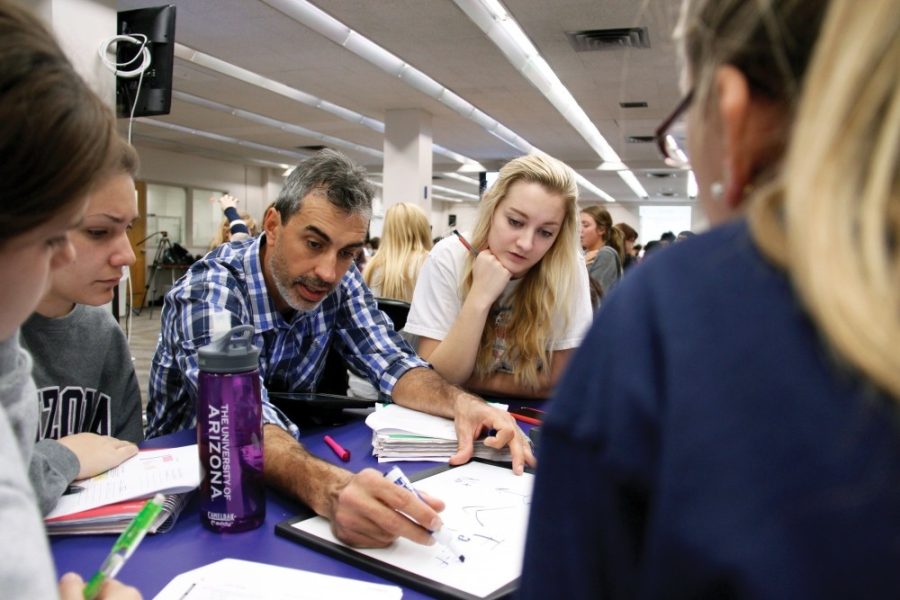With nine collaborative learning spaces on campus, thousands of students and hundreds of faculty now have the ability to learn and teach through active learning with the help of new technology.
In order to better help faculty members learn the technology needed to smoothly operate their classes, the Research Corporation for Science Advancement funded the Collaborative Faculty Room, a safe place for teachers to learn, make mistakes and help other teachers.
Collaborative classrooms began appearing two years ago when a pilot classroom furnished with party tables, folding chairs and vinyl table cloths was created on the south side of the UA Science-Engineering Library, according to Library Operations supervisor Carrie Muir.
RELATED: UA seeks to diversify faculty and improve hiring efforts
After the original classroom’s success, four other classrooms opened up across campus and this year four additional ones have opened up, making nine total.
Paul Blowers, a chemical and environmental engineering distinguished professor, who was one of the first teachers in the pilot space, said he made the scary transition from a lecture hall to an open space.
“The night before was terrifying because if you’re behind a podium you’re safe,” Blowers said. “All the sudden [in a collaborative classroom] you’re out in the middle of all the students and they don’t know where you are and you’re tripping over skateboards and backpacks. But then you get a little more comfortable with it and now I teach all but one of my classes this semester in a collaborative learning space.”
Blowers said he dislikes other classrooms because he cannot achieve the same level of discussion that he can in a collaborative learning space. According to him, 80 percent of students isolate themselves in classrooms like lecture halls, but in a collaborative classroom there’s nowhere to hide.
Zoe Cohen, an assistant professor of biomedical engineering and physiological sciences, was one of the first teachers to join after the pilot. She said she experienced a similar fear, but Blowers got her excited to teach in those rooms.
“You get to interact, you get one-on-one time even in a class of 200 students,” Cohen said. “It’s really transformed the way I teach and the way the students learn.”
Collaborative classrooms flipped the way students learn the material. Teachers are now mainly supporters and facilitators of discussion and the students do the “hard lifting” by talking to each other to figure out the problems presented, according to Cohen.
The Collaborative Faculty Room opened Sept. 23, and already, teachers are putting it to use and trying out the new technologies offered. By signing up on D!bs, teachers can reserve the space to practice with.
Another thing the Collaborative Faculty Room is doing is bringing teachers together.
“We have 100 faculty now that are having discussions every other week about teaching,” Blowers said. Colleagues can help each other with new technologies and build off of each other’s knowledge.
Blowers said the UA plans to convert four or five rooms into collaborative classrooms every year for the foreseeable future.
Some students, however, aren’t as thrilled about the collaborative classroom set up.
“The process of getting to the right answer helps you better understand what you’re doing, but at the same time the lack of any sort of direction in the beginning makes homework and assignments and pretty much everything take a lot longer,” said Alex Piatkiewicz, a chemical engineering junior. “So sometimes we understand the concepts better afterwards, but also sometimes we’re missing certain components of the concepts because they’re not directly taught and they’re not something we’re specifically looking for when we’re trying to solve a problem.”
RELATED: UA sets SAIL on new learning program
The adoption of solely active learning is the main problem, according to Piakiewicz, who said that a combination of alternating between lecture and active learning days to reinforce concepts would be better.
Piakiewicz said before the classrooms can match what the students need, teachers need to give more structure and instruction to the courses.
“If we had pre-recorded lectures that we could watch at home before we came into the active learning situation, I think it would be very helpful in filling those gaps,” Piatkiewicz said.
Follow Rocky Baier on Twitter.









